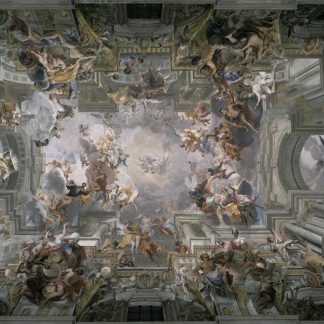The Architecture of Oblivion:
Andrea Pozzo’s Sant’ Ignazio Fantasy
3401 Walnut Street. A Wing.
Institute for Research in Cognitive Science, Room 470

The quadratura paintings in Rome produced in the 17th century by the Jesuit friar, Andrea Pozzo, have been among the most discussed in the modern discourse on perspective, and for good reason. Pozzo produced works of great scale and magnitude and then wrote about his methods in a widely distributed and read treatise. His vertiginous architectural projections in the church of Sant’ Ignazio in Rome seem to epitomize Baroque sensibilities, allying geometry to Jesuit theology, forging a powerful metaphor for colonial and missionary mastery of non-European worlds. There is a breath-taking totality to the frescoes in Sant’ Ignazio, a split-second flash in which the perspective coalesces into a single viewpoint that seems to instantiate a viewing subject as all-seeing, all-knowing, a fitting recipient of Catholic truth and dogma mirrored in the apotheosis of St. Ignatius that appears on the ceiling. While these readings are not incorrect, the extensive architectural projections and Pozzo’s embrace of anamorphic perspective can also be read against the grain. Destabilizing the central viewpoint, Pozzo’s imaginative scene counteracts traditional understandings of space and the presumed embodiment and centrality of the spectator and challenges the rational implications of perspective geometry.
image: Andrea Pozzo, Apotheosis of St. Ignatius, 1691-1694, fresco, Church of Sant’ Ignazio, Rome